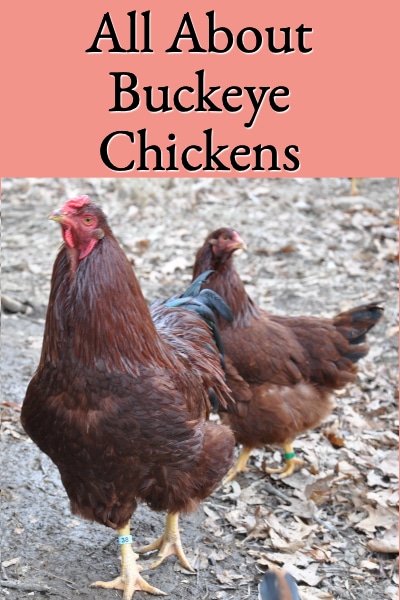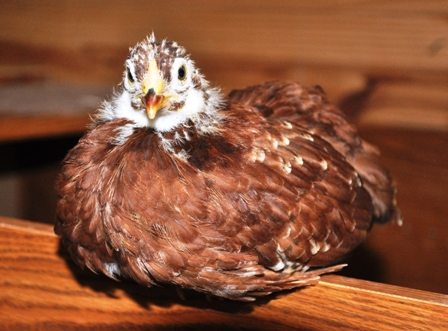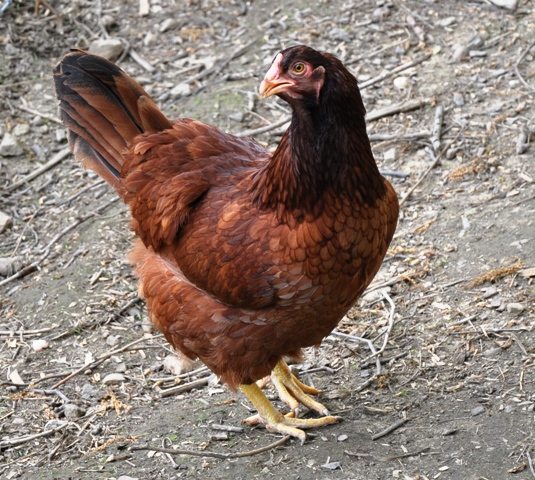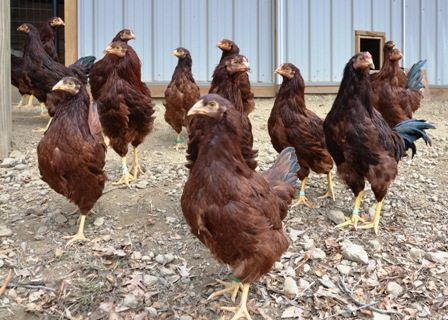
All About Buckeye Chickens
Well, Buckeye chickens are uniquely American, and they make wonderful dual-purpose (good for both meat and eggs) birds. They are the only American chicken bred by a woman and were bred specifically to thrive under harsh conditions. This makes them exceptional chickens for backyards, homesteads, and breeders alike.
Despite nearly being lost as a breed, today their versatility is rapidly being rediscovered. If you want large, beautiful birds that are good for both meat and eggs, that withstand heat and cold, and that are excellent foragers, then consider the Buckeye.
Buckeye Chicken Beginnings
In 1879, Mrs. Nettie Metcalf of Warren, Ohio began searching for a chicken that she could raise and sell to earn her own spending money. Prior to marriage, she’d been accustomed to having an income, and wanted a method to continue that income after becoming a farm housewife. She enjoyed the outdoors, exercise, and the challenges of raising chickens, but was dissatisfied with the results she got with the brown Leghorns her husband originally had on their farm. She described them as always being scrawny and in poor condition, and that there was “never a good season for chicken” with that breed.

Days Old Buckeye Chick
Mrs. Metcalf tried several other breeds, but none of them flourished (she later wrote that it was her ignorance of proper nutrition and housing that caused them to fail) so she began crossing breeds to create a chicken that would meet her requirements. She wanted a lively chicken that was good eating and a decent egg producer all year around. In addition, it had to survive by foraging on the farm (she didn’t feed a ration or grit), as well as withstand the hot Ohio summers and bitterly cold winters.
Eventually, she crossed Plymouth Rocks with Buff Cochins and got chickens that she described as “lazy, but good eating.” To make the chickens livelier, she procured black-breasted Red Game birds and crossed them with the Rock/Cochin offspring. This produced the first red-feathered chicken she’d ever seen, as well as chickens with a pea comb, yellow legs, and a Cornish body shape. At this point, she realized that the game birds must have contained some Cornish blood, but was pleased with the pea comb and body shape that they contributed. Mrs. Metcalf decided then that she would breed a hardy, red-feathered chicken from this beginning stock (and their farm became Red Feather Farm).

Buckeye Rooster
The roosters from this beginning were aggressive, so she spent several years working to eliminate their fighting instinct, and to consistently produce a red-feathered chicken that met her requirements for meat, eggs, and foraging ability. The resulting chickens she described as “large and vigorous and the very best layers we ever owned”, and she began selling them as Buckeye Reds. She described their color as “garnet”, but named them Buckeye because their color resembled that of the ripe Buckeye nut from her home state. In 1902, Nettie Metcalf submitted the birds for admission to the American Poultry Association Standard, and they were admitted as Buckeyes in 1904.
Buckeye Characteristics
Buckeyes are a dual-purpose chicken with deep mahogany plumage (there is only one color variety), yellow legs and skin, and pea combs. Because of the game bird in their makeup, they do particularly well in free-ranging conditions and are excellent foragers. Roosters weigh approximately nine pounds, and hens weigh approximately six and a half pounds and lay around 200 medium to large brown eggs per year. In the bantam Buckeye size, roosters weigh about 34 ounces while hens weigh about 28 ounces. They are the only American chickens that have a pea comb and have a slanted, short-broad back, meaty thighs, and powerful wings and breast. Their body shape and pea comb make Buckeyes extremely cold tolerant.
They also have unique personalities for chickens. They are very active, and are particularly good “mousers” – it’s unwise for a mouse to venture through Buckeye territory. Being very inquisitive, Buckeyes tend to run toward humans, rather than away like many chickens.

Several Week Old Buckeye Chick
Hens often retain their “setting and mothering” abilities and can go broody, traits appreciated by those wanting to maintain small, self-perpetuating flocks. The chicks grow relatively fast and benefit from a higher protein feed for the first 8 – 10 weeks. Chicken starter feeds typically contain around 20 percent protein, so many Buckeye owners use a game bird or turkey starter at first (which typically contains 28 – 30 percent protein). Buckeye roosters are known for their gentle dispositions, excellent flock protection skills, and a wide range of vocalizations. It’s not unusual to hear everything from a purr to a roar from a Buckeye rooster.

Buckeye Hen
Buckeye Chicken History
After admission to the Standard, Buckeyes were a very popular homestead chicken for nearly fifty years because of their hardiness, productivity, foraging ability, and inquisitive nature. However, after World War II, poultry production commercialized and moved indoors, and the Buckeyes were never selected by commercial producers. That, along with the demise of backyard flocks in the US during the last half of the 20th century, caused Buckeyes to become classified as critically endangered. In 2003, there were less than 72 known breeding birds left in the United States.
Most of the remaining Buckeyes also exhibited decreased productivity when compared to the birds originally bred by Nettie Metcalf. Because of increased availability of chicks from large hatcheries, once commonly known selection techniques for maintaining chicken breed productivity were largely lost in the US, and the productivity of many non-commercial breeds declined. So in 2005, The Livestock Conservancy began a program to recover the Buckeye’s original characteristics – striving to return Buckeyes to the productive breed it once was.
The Livestock Conservancy Rescues the Buckeye
In 2005, The Livestock Conservancy selected the Buckeye breed for their pilot chicken breed recovery project. The purpose of the project was to see if traditional selection techniques found in early to mid-20th century poultry texts could be used to return a rare breed to the productive homestead breed it once was. The program was highly successful, and after just three generations, the Buckeye chickens grew to size two weeks faster, weighed a pound more, had improved egg production, and again matched the published American Poultry Association Standard for the Buckeye breed.
Buckeyes Today
The recovery project was very successful, and today, Buckeyes descended from the Livestock Conservancy project birds are making a comeback as excellent purebred chickens for flavorful meat, good egg production, and even exhibition.
For meat, Buckeyes mature slower than commercial factory chickens, and the meat is consequently more flavorful. Most commercial chickens are raised to the age of 8 weeks, whereas Buckeyes are usually raised to the age of 16 weeks. This produces meat with a richer, nuttier flavor, but it’s also more muscular and needs to be cooked with tenderness in mind (i.e. slow cooking or brining). Because of the outstanding flavor of the meat, Buckeye chickens have been included in the Slow Foods Ark of Taste.
Buckeye egg production is typically described as being between 150 – 200 eggs per year; however, after the recovery project, egg-laying improved to 175 – 240 eggs per year. Since then, some breeders have continued to work at selecting Buckeyes for egg production, and today there are Buckeye lines that are known for production rates even higher than those of the Livestock Conservancy descended birds.

Broody Buckeye Hen
In 2007, one of the project descendants shocked the chicken exhibition world by winning Reserve Grand Champion in the American class at the Ohio Nationals. Since then, Buckeyes have won numerous Reserve Grand Champion, Champion American, and Champion Large Fowl awards, and in May of 2013, again made history when a Buckeye was awarded “Best of Show”.
Buckeye chickens are increasingly popular, and on the “good news front”, in 2011 Buckeyes were upgraded from “Critical” to “Threatened” status based on 2010 census data reporting more than 2,400 birds. Today, it’s estimated that there are more than 5,000 Buckeyes, and Mrs. Metcalf’s “garnet” birds have indeed become the red-feathered jewels of the chicken world. If you’re looking for an exceptional backyard or homestead chicken, be sure to consider the Buckeye.
New Buckeye Strains
The original Bramblestone Farm Buckeyes were from the Livestock Conservancy “strain” described above, which were developed from the Urch, Pearce, Brown and Rhodes flocks beginning in 2006. The strain was developed to promote diversity of lines and more rapid growth in the birds, rather than necessarily promoting either egg or meat production. And although we really enjoyed those original Buckeyes, we did wish for better egg production.
The latest Bramblestone Buckeye’s came from Crains Run Ranch, and were bred by Mr. Jeff Lay. In 2002, Mr. Lay began breeding Buckeyes for improved egg production, and today the “Lay” strain of Buckeyes are known for their excellent egg production. They were developed from Buckeyes from the Brown (OH), Rhodes (MA), Pierce (RI), and Urch (MN) flocks. See Raising Buckeye Chicks to read our lessons learned when raising Buckeye chicks.

Free-Ranging Buckeyes
More Information/Finding Breeders
The American Buckeye Club – The American Buckeye Club is dedicated to the preservation of the Buckeye Chicken and is a place for Breeders, Hobbyists, Fanciers and Poultry Enthusiasts to share information about this exceptional breed of fowl. http://americanbuckeyeclub.org
American Buckeye Poultry Club – The American Buckeye Poultry Club is a registered non-profit breed club created in 2008 to promote and support the Buckeye chicken, both large fowl and bantam. http://www.americanbuckeyepoultryclub.com

Dennis says
I hatched several Buckeye eggs I received from my brother-in-law who lives in Ohio. He has had Buckeye chickens for years and that’s the only breed he has. They seem to meet the characteristics described above. I hatched several eggs from these offspring and one ended up with a barred feather pattern. Sort of a crele look. Is this something that occasionally?
Lesa says
Hi Dennis, I’m sure this is something that breeders are trying to breed out; however, since Buckeyes are descended from the Plymouth Barred Rock breed (as well as others), I’m sure it’s something that occasionally shows up.
Alex says
Buckeyes are a great breed and this article has really good info! Thanks! Looking into adding some buckeyes to our farm!
drknstodstny says
Hey there Bridger. I know this article answered your question already but we purchased a handful of Buckeye chickens from Meyers Hatchery online. They are now 6 months old and are looking so beautiful and healthy. They are quite friendly and very inquisitive too. Hope this helps you or anyone else. Be eggcellent!:)
Lesa says
It says in the blog post above where we bought the birds from. They probably would be great for northern Minnesota!
Dennis says
I sent you an email recently but have yet to receive a reply. My question concerned whether or not a barred feather pattern may occasionally show up in Buckeye chickens.
Thanks,
Dennis
Keli says
I am concerned about the noise, and I know that Cochins are one of the quieter breeds, but are Buckeyes also quiet(er) or did they assume the vocal tendencies of another breed?? Thank you in advance for any information you may be able to provide. 🙂
Lesa says
Hi Keli,
Our Buckeye hens are very quiet, the Buffs make lots more noise than them. Now, the roosters are a different story……….
Paulina says
I’ve had in the ballpark of 75+ Buckeyes in the past 5 years. Some got picked off by predators, some were eaten, because we keep them for meat and eggs. Buckeye hens are in my experience quiet and docile. The exception was our Thanksgiving “turkey” one time. One hen out of several dozen was “mean”.
The roosters (I have three on last count, the math varies, since I hatch my own birds) are loud, and start early, this time of the year they get going at about 4 am. I’m having a “great” time with the teenage roosters practicing with their dad starting before sunrise every day under our bedroom window. The cacophony is loud, and ongoing. It gets better when they figure it out.
In free range conditions on larger properties, if local codes allow, roosters protect the hens. Just make sure to cull the roosters that are people aggressive. That aggression is passed down to their offspring. You want “tough guys with heart”. Our current alpha rooster follows me like a puppy and is attentive to his ladies and gently keeps his teenage rooster sons in line, but he’s also fought off a coyote and won, so he’s got spunk when it’s needed. Hens with a rooster don’t tend to let people touch them as much, so I often hand-rear the chicks so they think of me as their mom to make them easier to handle.
Lesa says
Thanks Mark for your contact information – I’ll contact you in spring to let you know what’s available!
Kevin Lewis says
Thank you for the info about the Buckeyes we have a chance to buy some young poulets
Lesa says
Hi Kevin, Lucky you – enjoy those Buckeye pullets!
Ansrea says
Thank you for this! Searching for heritage breed info that isn’t just a repeat of the SOP is incredibly helpful! The info I’m really looking for is how Buckeyes would do with two 8yr old boys who want to do chickens for 4H and can they live peacefully with ducks that we need for wetland mosquito control. The chickens will of course patrol the dry land but they would share night time quarters for at least a year or two.
Lesa says
Hi Ansrea,
I think that the Buckeyes would do very well with two 8 yr old boys, they are quite friendly and if handled regularly should make great chickens for 4H. I also think they would live peacefully with ducks, although we haven’t tried that. They seem to be quite social, you just don’t want to be a mouse or insect in their space.
Valencia Harruff Castillo says
Based on what I have read in the comments, you would not recommend the Buckeye for Florida? I would love to start having chickens and based on my research this is one of my favorite breeds. But I wouldn’t want to get any if my climate would not be good for them. Suggestions?
Lesa says
Hi Valencia, the Buckeyes were developed to be a breed that would survive well in Ohio’s climate, which is obviously much colder than Florida. I don’t have any experience with keeping Buckeye’s in a warmer climate, so I can’t really say that I would recommend them for Florida. Perhaps you could inquire with either of the breed clubs to see if anyone has any experience with them in warmer climates.
Steve says
Hello I have 10 Buckeye hens and 1 rooster. I was wondering when they will start laying eggs. They are about 20 weeks old right now. I have taken them off the hatch to hens food and put them on a laying food with extra calcium.
Lesa says
Hi Steve, they will probably start laying at around 24 weeks, and they really shouldn’t have the hens food with extra calcium until they do start laying. Starting them on the extra calcium earlier will not cause them to start laying any earlier and can do damage because they can’t use it until they start making eggs.
Sarah Mueller says
We are just getting into chickens and are so excited! We are in the research stage and came across your site when we googled Buckeye chickens. Great site!! Do you recommend Buckeye chickens for first-timers? Also, they will not be free range and will have a caged in area of 92 feet by 12 feet. Anything that we need to know to make an informed decision will be greatly appreciated:) Have a fantastic day!
Lesa says
Hi Sarah, I do recommend Buckeyes for first-timers, they’re very inquisitive and friendly, especially if they’re socialized (handled frequently) from day-old chick stage. The Buckeyes do not need to be free-range, but they do better with some area to roam in, but it sounds like you’ve got that covered. I don’t know where you’re located, but the Buckeyes do better in colder climates than in warmer climates. Some Buckeyes have been bred for better egg-laying while others are more meat birds, so if you decide on them, you might want to get birds from lines that match your priorities for the birds.
Niki says
Hi there,
Live on a five acre plot in southern Michigan. We have layers and meat fowl. Could really use some help with the move and voles. Do you really see your Buckeyes catching more critters then your other chooks?
Lesa says
Hi Niki, We really do see our Buckeyes catching more critters. They like to get our mice! I think maybe because of the game bird bred into them.
Michelle says
I thoroughly enjoyed this article. I am looking to add Buckeys to my flock. Can you recommend a hatchery or breeder that has maintained the original qualities of the breed?
Thank you!
Michelle
Edward Yurchick says
Check out Meyer hatchery in Ohio.
Mary Ann says
Hello,
I live near Warren, Ohio and have 7 Buckeye hens that I have raised from peeps. They are gorgeous, friendly, inquisitive birds but to date I have not received one egg from them. (I got them in late April) In addition, one of them has bulging eyes and seems nearly blind. I originally had 12 peeps but gave 4 to a friend and had one (my favorite one) die just a couple weeks ago. She had a scissor beak and I spoon fed her twice a day. She was only twice the size of a pigeon but she was so friendly– I really miss her. I have raised chickens for the past 6 years and this is the first group that I have had any issues with in terms of laying or illness. Is this normal?
I appreciate any input you can give.
Thanks
Lesa says
Hi Mary Ann, I’m really sorry you’re experiencing these problems with the Buckeyes, and I think that it’s not normal. We’ve raised multiple groups of Buckeyes from peeps, and have not had issues like yours. Our Buckeyes have been very hardy, and the latest are really good layers too. I think that it’s important to watch where you’re getting Buckeye peeps from, it seems that some hatcheries, etc. have not maintained the original qualities that made the birds so well suited to our Ohio climat and so productive. Do you know what strains your birds came from?
Lesa says
I so agree Eliza, such a proud and loving breed!
Shumaker Farm says
Buckeyes are a great breed. Those that aren’t familiar with the breed should look into finding out more about them. Not only are they a great dual-purpose fowl; they can be pretty competitive in the exhibition world when bred correctly. Mrs. Metcalf left all of us a well written description of her beloved fowl and its up to all of us to maintain her vision. Yes….there are two clubs but the information and personalities within are worlds apart. My website has a great deal of useful information surrounding this wonderful breed accompanied with many exception details on what this breed should be.
Lesa says
Hi Joe, I know you’ve been very successful in breeding and exhibition, so I’m looking forward to reading through the details on your site!
Shumaker Farm says
Lesa, sounds great! If you have any questions on anything I’ve added to my site; by all means….please ask!
Lesa says
Hi Laura, sorry don’t know where my head was, I should have provided a link to the American Buckeye Poultry Club too – thanks for reminding me and I’ve now added it.
Laura Haggarty says
Thanks! We do appreciate it.
lauren scheuer says
So nice to read this article. I have one Buckeye, Scarlett, not yet a year old, and she is a truly fascinating and intelligent bird. She’s also absolutely smitten with my dog….much to his frustration. 🙂
Lesa says
Hi Lauren, glad to hear you find Scarlett fascinating and intelligent, we certainly find ours to be that way too – I’ve not heard of a Buckeye being smitten with a dog before, that sounds very interesting 🙂 What kind of dog is he?
sarah eller says
I was so pleased to wake up to read this post! Like you we have fallen in LOVE with our Buckeyes!! I was only able to hatch 2 and both were hens. To my amazement I met a friend that raised them, great lines to boot! She has so kindly gotten us started with hatching eggs. I just hatched the first 10 and have close to 10 more I’m praying will make their debut on Friday!! No need to convince me of their perks!
Thanks so much for spreading the buckeye love. As well as all the great recipes written for the homestead/farmstead wife! I’m absolutely addicted to reading everything I can get my eyes on your site! Bless you and your family!!!!
Sarah
Lesa says
Hi Sarah, I’m so glad that you’ve found Buckeyes and love them like we do 🙂 Thank you for reading Better Hens and Gardens, and blessings back to you and your family!
Janet Garman says
I would really like to raise some Buckeye chickens. You have the most beautiful pictures of yours. I love the dark colors and the somewhat Brahma like feathering. Thanks for an informative post
Lesa says
Thank you Janet, we’ll have to discuss you raising some Buckeyes 🙂